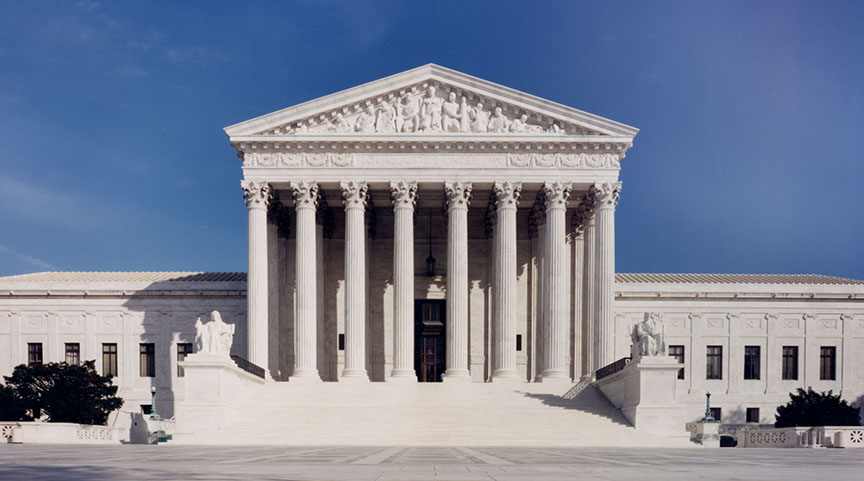In response to the nomination of Judge Amy Coney Barrett to the United States Supreme Court by President Donald Trump, Democrats are threatening to “pack” the Supreme Court. On the campaign trail Vice President Joe Biden has refused to address whether he would support a measure to “pack” the Court. The threat of “packing” the Supreme Court should alarm every American because it threatens the very foundations of our constitutional republic. Democrats are following the path of President Franklin D. Roosevelt (FDR), who in 1937 attempted to “pack” the Supreme Court. During the debate over FDR’s Court “packing” plan former President Herbert Hoover led a charge to defend both the Constitution and an independent judiciary.
In the presidential election of 1936 President Roosevelt routed the Republicans in a landslide victory. President Roosevelt interpreted his reelection victory as a mandate to continue his New Deal reform programs to combat the Great Depression. Nevertheless, President Roosevelt was frustrated because the Supreme Court struck down several prominent New Deal programs, most notably the Agricultural Adjustment Act (AAA) and the National Industrial Recovery Administration (NRA).
Roosevelt was especially angry with the four conservative Justices of the Supreme Court who he referred to as the “four horsemen of the apocalypse.” The conservative Justices included Willis Van Devanter, James McReynolds, Pierce Butler, and George Sutherland. Chief Justice Charles Evans Hughes and Justice Owen Roberts often joined with the conservatives to strike down New Deal laws. It was not always just the conservatives deciding to invalidate New Deal laws. For example, the entire Hughes Court agreed that the NRA was unconstitutional.
President Roosevelt decided to utilize the political capital he had won in the 1936 election by proposing to reorganize the judicial branch. Roosevelt argued that reforming the Court was necessary because the “nine old men” could not keep up with the caseloads and the judiciary needed to “modernize.” Further, Roosevelt argued that the judiciary was “handicapped by insufficient personnel with which to meet a growing and more complex business.”
The goal of Roosevelt’s judicial reorganization was not to modernize the judicial branch but attempt to prevent the Supreme Court from blocking further New Deal reforms. Progressives argued that the Constitution was a “living” document that evolved with the times. Roosevelt even criticized the Supreme Court for using a “horse-and-buggy definition of interstate commerce” in declaring New Deal laws unconstitutional.
“This plan of mine is no attack on the Court; it seeks to restore the Court to its rightful and historic place in our Constitutional Government and to have it resume its high task of building anew on the Constitution ‘a system of living law,’ stated President Roosevelt.
Progressives argued that modern society demanded that the federal government move beyond constitutional limitations to solve policy problems. As Roosevelt stated:
Modern complexities call also for a constant infusion of new blood in the courts, just as it is needed in executive functions of the Government and in private business. A lowered mental or physical vigor leads men to avoid an examination of complicated and changed conditions. Little by little, new facts become blurred through old glasses fitted, as it were, for the needs of another generation; older men, assuming that the scene is the same as it was in the past, cease to explore or inquire into the present or the future.
At the heart of Roosevelt’s plan was to appoint a new Justice to the Supreme Court for every Justice over the age of 70. This would allow Roosevelt the ability to appoint six new Justices to the Court. In a “fireside chat” with the American people Roosevelt defended his plan by arguing that he wanted an “independent judiciary” and a Supreme Court that “will enforce the Constitution as written…”
“We have, therefore, reached the point as a nation where we must take action to save the Constitution from the Court and the Court from itself,” explained Roosevelt. The President also argued that Congress had the constitutional authority to determine the number of Justices on the Supreme Court.
The Court reform plan was one of the most radical measures proposed by President Roosevelt. The plan was not a legitimate reform of the judiciary, but an attempt to “pack” the Supreme Court with Justices who would be sympathetic to Roosevelt’s New Deal agenda. Roosevelt was soon confronted with opposition to his court “packing” plan not only by Republicans and conservatives, but also members of his own Democrat Party.
Former President Herbert Hoover had warned the nation about the consequences of the proposed New Deal during the 1932 presidential campaign. As the New Deal unfolded Hoover argued that there were “nests of constitutional termites at work.” This was certainly true with the Court “packing” plan, and Hoover argued that it had the “implication of subordination of the Court to the personal power of the executive.”
Hoover described Roosevelt’s plan as the “greatest constitutional question in these seventy years.” The independence of the judiciary was at stake. Further he argued that “it is the duty of every citizen to concern himself with this question.” In addition, he understood that Roosevelt’s ulterior motive was to appoint Justices that would be favorable to his own philosophy. “If this is to be accomplished the new judges must necessarily be men who will ratify Mr. Roosevelt’s projects,” stated Hoover.
If Roosevelt succeeded in “packing” the Supreme Court, it would establish a precedent for future administrations. As Hoover explained:
If Mr. Roosevelt can change the Constitution to suit his purposes by adding to the members of the Court, any succeeding President can do it to suit his purposes. If a troop of ‘President’s judges’ can be sent into the halls of justice to capture political power, then his successor with the same device can also send a troop of new ‘President’s judges’ to capture some other power. That is not judicial process. That is force.
Membership of the Supreme Court had remained at nine Justices since 1869. In the past Congress had either reduced or expanded the number of Justices on the Court, but Roosevelt’s plan was seen as an attempt to not only control the judicial branch, but it would solidify his control over the executive and legislative branches. President Roosevelt had increased executive power and the strong Democrat majorities provided rubber-stamp approval for his New Deal legislation in Congress.
“The independence of Congress, the Executive, and the Supreme Court are pillars at the door of liberty,” stated Hoover.
Hoover also directly challenged the notion that the Constitution was a “shackle on progress” as Roosevelt and other New Dealers had argued. It was the Supreme Court that was protecting liberty and upholding the Constitution against Roosevelt’s New Deal measures that went well beyond constitutional bounds. “The American people should thank almighty God for the Constitution and the Supreme Court,” stated Hoover in referring to the Court’s defense of the Constitution.
Roosevelt’s court “packing” proposal would fail because of the bipartisan opposition, but eventually he would be able to appoint his own justices to the Court after the “four horsemen” started to retire. The Supreme Court also started to shift in a more progressive direction with the “switch in time that saved nine” when Justice Owen Roberts sided with the progressive wing of the Court.
In the aftermath of the Court “packing” fight President Roosevelt was able to not only shift the Supreme Court in a more progressive direction, but it created a revolution in constitutional law. “The Court began rewriting the Constitution, in effect, not through amendment by the people, the proper way, but by reading the document as it hadn’t been read for 150 years — as authorizing effectively unlimited government,” stated Roger Pilon, who holds the B. Kenneth Simon Chair in Constitutional Studies at the Cato Institute.
Many of Roosevelt’s arguments in favor of court “packing” are being revived by the Democrat Party. Senator Mike Lee (R-UT) wrote in First Things that “one political party is threatening to undermine one of the republican checks included in the Constitution —the Supreme Court — with a plan to pack the Court with progressive judges.”
Democrats are upset that Judge Amy Coney Barrett will soon be appointed to the Supreme Court. During the confirmation hearings Senate Democrats on the Judiciary Committee focused extensively on the Patient Protection and Affordable Care Act (ACA). Democrats argued that if Judge Barrett is confirmed it will result in the Supreme Court striking down the ACA. Democrats are following Roosevelt’s example of a “living” Constitution and they fail to understand that the function of the Supreme Court is not policy but defending the Constitution. If the ACA is unconstitutional then it is the responsibility of Congress to find an appropriate solution to health care. President Roosevelt as well as today’s Democrats believe that the Supreme Court should be an agent of change and the Constitution should not stand against progress.
Judge Barrett’s constitutional philosophy of originalism closely resembles that of the late Justice Antonin Scalia. Democrats view originalism similar to Roosevelt’s criticism of the “four horsemen” for examining the Constitution with “old glasses.” However, originalism best adheres to the principles of the American Founding. President Trump has already appointed two Justices to the Supreme Court and numerous other judges in the federal judiciary. However, just because Democrats oppose a conservative shift on the Supreme Court does not provide a legitimate reason to “pack” the Court. During President Roosevelt’s time in office he appointed eight Justices to the Supreme Court. Constitutional law is still being impacted by the legacy of the New Deal constitutional revolution.
Americans deserve to know whether Vice President Biden and the Democrat Party plan to “pack” the Supreme Court. An independent judiciary is vital to our constitutional republic. Let us remember Herbert Hoover’s battle cry in 1937, “Hands off the Supreme Court.”
















